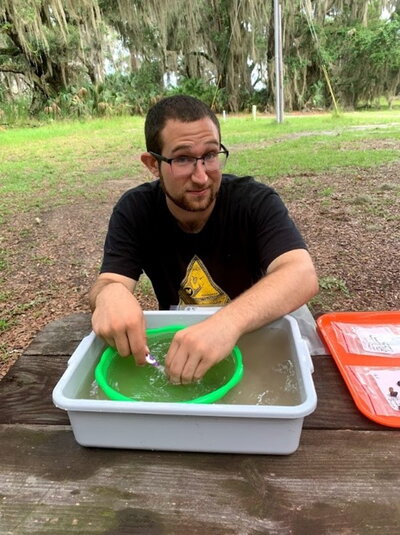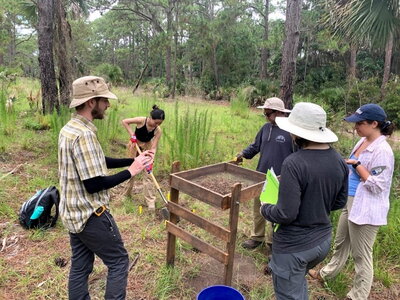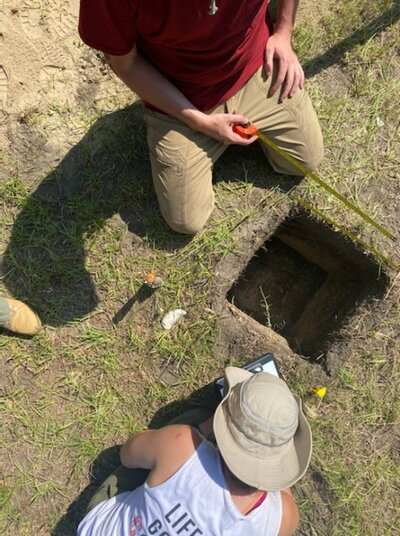
I am Miles Ury, a senior at the University of Illinois Champaign-Urbana(UIUC) pursuing a double major in Archaeology and Statistics.
This past summer(2021) I attended a field school run by UIUC that took place at the Kenan Field site on Sapelo Island, Georgia, and was spearheaded by Dr. Ritchison, a professor at the university.
The field school actually existed, was safe in the U.S. despite COVID, was run by my university, and was run by a teacher who I had a positive classroom experience with the previous semester, so choosing to attend it was a no-brainer for me.
The ultimate goal of the field school was to function as a learning experience, but research questions and goals were also taken into consideration. Dr. Ritchison’s research goals included finding evidence of the existence and purposeful placement of household structures in Mississippian culture, as well as further general surveillance of the site using a combination of destructive and nondestructive methodologies.
Each workday was organized, busy, and devoted to education and research. We woke up at 6am and had to be packed and ready to go to the field by 7am. After a bumpy, rambunctious truck ride to the field, we were told what our jobs were for the day and separated into groups of two or three, depending on how many people were needed. We worked from 7:30 to 11:30, had a lunch break, and then worked from 12:00 to 3:00. We put all of our equipment away in the storage trailer before riding in the truck back to our house, the ABAC shack. We then turned in our bags of artifacts and paperwork, to be processed and entered into a database at a later date. The rest of the day was our time to do work or chill, save for fun communal dinners at around 5:30. After some games, movies, interesting conversations, and random wildlife encounters, we all were in bed by 10:00 to prepare for our next workday.

Over the course of five and a half weeks, we learned and practiced a lot of field skills. One of the fundamental skills we learned and practiced was how to perform a shovel test. These are systematically distanced holes with consistent, predetermined dimensions that allow for basic subterranean surveillance. The holes were dug, dirt sifted, and data recorded by level in order to preserve contextual information. I learned the most important fundamentals of archaeological data from these tests. Some examples of this include what shells, pottery, bones, and worked stones look like among a pile of dirt, how to use a variety of digging, measuring, and sifting tools, the information that is useful to record, and why, and what the difference is between a regular assortment of artifacts versus something so interesting and unusual that we had to call the professor over, among other lessons. In the field school there was a club for those who were required to dig a meter into the ground called the meter club. I remember the first time I hit the meter club, we found a large piece of an object around 55 cm into the ground, and we didn’t know what it was because it looked like pottery on the outside but broke like charcoal. After digging down another 20 cm and finding even larger pieces of this object, we called the TA over, and she told us that we had found many rare fragments of Archaic period pottery, which was thousands of years older than the objects we were trying to examine. It stopped occurring eventually, but the artifacts caused us to dig a meter beneath the surface. I remember jokingly complaining about how far we would have to dig and joining the meter club, but it was an amazing experience to find a cultural artifact that was thousands of years old.
We also learned how to dig a unit, which is basically a larger, more careful version of a shovel test. Units were much longer and wider than shovel tests, each level was shallower, and there was more data to record. We learned how to shave the ground instead of simple digging, how to measure using a datum string, how to accurately draw the side or floor of a large hole onto a piece of graph paper, and how to mark any important features that were found within a unit. The unit built on skills from the shovel test, with quite a few extra steps since we believed that the likelihood something significant would be found there was higher.
We had a general idea of where artifacts were likely to be found due to the other main thing that we were able to participate in during the summer: running Ground Penetrating Radar(GPR). GPR sends millions of radio waves into the ground and can calculate the depth and relative shape of objects within the earth based on how much time the waves take to bounce back to the machine that sent them. We had to learn the basic science behind it, what kind of objects it could detect, and what kind of data was useful to record. To increase the effectiveness of the GPR, we had to perform another simple but essential skill for archaeology: brush clearing. There was one morning early on in the trip where the 12 undergrads spent four and a half hours chopping down everything that wasn’t grass or a full-blown tree within a 40 by 40-meter square on the island. We each drank 3 liters of water and were exhausted afterward, but it allowed for the radar to be used effectively since there wasn’t any excess vegetation that could alter the GPR data. It also led to the placement of units that ended up possibly yielding household evidence, so the hard work was worth it.
After attending the field school, I can say that it was educationally, philosophically, and socially life changing.

First off, I didn’t even know that Sapelo Island existed, so going from that to learning terminology, settlement and subsistence patterns, and current work was a daunting but fulfilling and immersive task. It was hands-on practice in learning about the holistic picture of a culture from the perspective of an archaeological researcher.
I went from knowing nothing about the practical aspects of archaeological data collection to being confident enough in the foundations to make informed decisions on my own in the field. I feel like I could show up to any type of basic survey in America and understand most of the terminology and objectives of a project after one or two explanations.
I further understood the types of questions archaeologists ask and work together on as a team, as well as learned about many ways that different people engage with and are passionate about archaeology. The opportunity to converse with peers as well as mentors on the field school gave me insight into how people think about their work, the solution mindsets of different people, and caused me to rethink my passions and skills in archaeology.
I learned essential team working and living skills, and had experiences that transformed a group of bright-eyed, mildly acquainted undergrads into lifelong friends. For a historically inadequate group project member such as myself coming out of a year where group activities were impossible due to COVID, this experience reinvigorated my spirit of learning and communication.
The field school provided me with knowledge, skills, and networks of people that would have been otherwise impossible; it will certainly impact the rest of my life and made me more excited to be involved in the archaeological world.